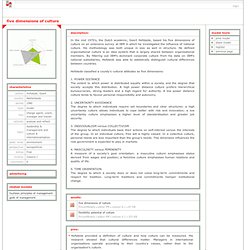

1748-5908-4-67.pdf (application/pdf Object) Overcoming Cultural Barriers to Change - Change Management Training from MindTools. Moving to a High Performance Culture How will you get round the barriers?

© iStockphoto/Inok How does your organization approach change? Do people respond with a sharp intake of breath when they first hear about a proposed new initiative, and then go on to try and find reasons why it won't work? Or do they react by saying things like "What a great idea, and we could also.. " Corporate culture is a powerful force that runs through every organization.
When successful change is the desired outcome, these cultural factors play a very important role. Effecting change is difficult at the best of times. It is worth remembering here that while culture issues can present barriers to change, they can also support change and goal achievement. There is no such thing as a perfect culture. The Characteristics of High-Performance Cultures By definition, one of the main differences between high-performance cultures and low-performance ones is... ... for the complete article: Join now for just $1, first month.
Culture's consequences: comparing values, behaviors, institutions, and ... - Geert H. Hofstede, Geert Hofstede. Geert Hofstede. The word "culture" stems from a Latin root that means the tilling of the soil, like in agriculture.

In many modern languages the word is used in a figurative sense, with two meanings: The first, most common, meaning is "civilization", including education, manners, arts and crafts and their products. It is the domain of a "ministry of culture". The second meaning derives from social anthropology, but in the past decades it has entered common parlance. It refers to the way people think, feel, and act. The two meanings should not be confused. Human culture is the result of hundreds of thousands of years of evolution.
An individual human being acquires most of her or his programming during childhood, before puberty. Today's world population is divided into some 200 nations. Five dimensions of culture - Geert Hofstede. In the mid 1970's, the Dutch academic, Geert Hofstede, based his five dimensions of culture on an extensive survey at IBM in which he investigated the influence of national culture.

His methodology was both unique in size as well in structure. He defined organisational culture is an idea system that is largely shared between organisational members. By filtering out IBM's dominant corporate culture from his data on IBM's national subsidiaries, Hofstede was able to statistically distinguish cultural differences between countries. Hofstede classified a county's cultural attitudes as five dimensions: The extent to which power is distributed equally within a society and the degree that society accepts this distribution.
The degree to which individuals require set boundaries and clear structures: a high uncertainty culture allows individuals to cope better with risk and innovation; a low uncertainty culture emphasises a higher level of standardisation and greater job security. Hofstede's Cultural Dimensions - Leadership Training from MindTools. Understanding Workplace Values Around the World Learn how to be more sensitive to the needs of people in different cultures.

We know that we are living in a global age. Technology has brought everyone much closer together. This means that people of different cultures find themselves working together and communicating more and more. This is exciting, but it can also be frustrating and fraught with uncertainty. Building connections with people from around the world is just one dimension of cultural diversity. How can we understand cultural differences? Fortunately, psychologist Dr Geert Hofstede asked himself this question in the 1970s. With access to people working for the same organization in over 40 countries of the world, he collected cultural data and analyzed his findings. He scored each country using a scale of roughly 0 to 100 for each dimension. The Five Dimensions of Culture The five dimensions are: 1. 2. 3. 4. 5.
Note: Hofstede's analysis is done by country. Key Points. Cultureandcomplexity.pdf (application/pdf Object) Strategies to change organisational culture to improve healthcare performance.